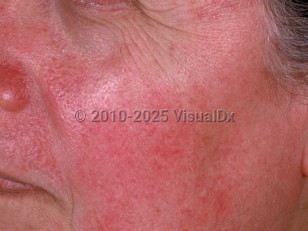Tumid lupus erythematosus
Alerts and Notices
Important News & Links
Synopsis

Tumid lupus erythematosus (TLE) is a relatively uncommon variant of chronic cutaneous lupus erythematosus. Patients typically present with asymptomatic, edematous, erythematous papules and plaques with no surface changes, most commonly on the trunk, face, and neck. Photosensitivity is a hallmark feature: lesions are often brought about by ultraviolet (UV) light exposure. However, TLE lesions may also present on skin not exposed to the sun. TLE shares many features with reticular erythematous mucinosis (REM), to the extent that many authorities consider them to be related entities. However, lesions of REM tend to have a reticular appearance, which differentiates this entity from TLE.
In general, TLE is a skin-limited condition. It is characterized histologically by a lymphocytic infiltrate of T-cells with a CD4:CD8 ratio of roughly 4:1, differentiating this from other clinical mimickers with predominant CD8 infiltration such as pseudolymphoma. Koebner phenomenon (isomorphic response) and relapses at sites of trauma have been reported.
Antinuclear antibody (ANA) positivity occurs in a very small subset of patients, and 10% of patients with systemic lupus erythematosus (SLE) will have lesions consistent with TLE. In addition, there have been a few reports of patients with TLE occurring with discoid lupus erythematosus. Females seem to be affected more frequently than males. The youngest reported patient to date was 16 years old.
In general, TLE is a skin-limited condition. It is characterized histologically by a lymphocytic infiltrate of T-cells with a CD4:CD8 ratio of roughly 4:1, differentiating this from other clinical mimickers with predominant CD8 infiltration such as pseudolymphoma. Koebner phenomenon (isomorphic response) and relapses at sites of trauma have been reported.
Antinuclear antibody (ANA) positivity occurs in a very small subset of patients, and 10% of patients with systemic lupus erythematosus (SLE) will have lesions consistent with TLE. In addition, there have been a few reports of patients with TLE occurring with discoid lupus erythematosus. Females seem to be affected more frequently than males. The youngest reported patient to date was 16 years old.
Codes
ICD10CM:
L93.2 – Other local lupus erythematosus
SNOMEDCT:
200941006 – Lupus erythematosus tumidus
L93.2 – Other local lupus erythematosus
SNOMEDCT:
200941006 – Lupus erythematosus tumidus
Look For
Subscription Required
Diagnostic Pearls
Subscription Required
Differential Diagnosis & Pitfalls

To perform a comparison, select diagnoses from the classic differential
Subscription Required
Best Tests
Subscription Required
Management Pearls
Subscription Required
Therapy
Subscription Required
References
Subscription Required
Last Reviewed:09/09/2018
Last Updated:09/10/2018
Last Updated:09/10/2018
Tumid lupus erythematosus

